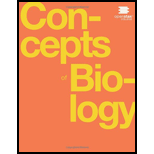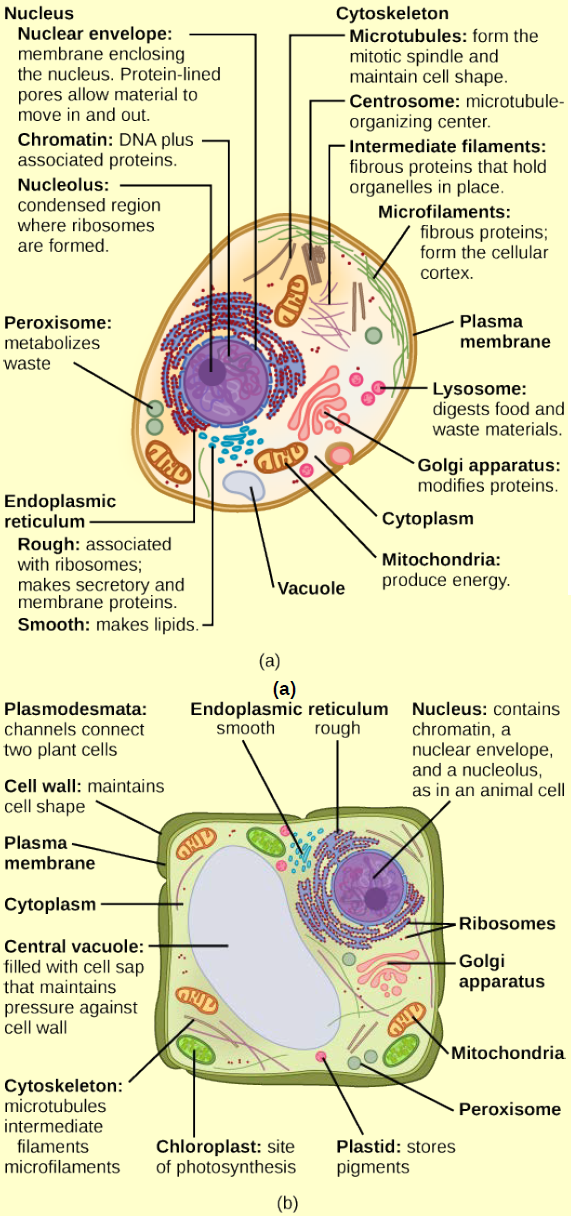
Concept explainers
Figure 3.7 What structures does a plant cell have that an animal cell does not have? What structures does an animal cell have that a plant cell does not have?

Figure 3.7 This figure shows (a) a typical animal cell and (b) a typical plant cell.
To analyze:
The similar characteristics and different features of plant cells and animal cells.
Introduction:
Both plant cells and animal cells are eukaryotic cells and have some common features. The plasma membrane, cytoplasm, nucleus, mitochondria, endoplasmic reticulum, Golgi apparatus, and ribosomes are the structures present in both plant and animal cells. Besides these structures some structures such as chloroplast, cell wall, a central vacuole are exclusively present in plant cell and similarly centrosomes, centrioles and lysosomes are present only in animal cells.
Explanation of Solution
A typical plant cell possesses a cell wall, plasmodesmata, a large central vacuole, chloroplasts, and other plastids. These structures are absent in animal cells. The cell wall is a rigid covering which protects plant cells and gives structural support to the plant cells. Plasmodesmata are the channels which connect cell to cell and involves in the transportation of materials. The water in plant cells is regulated by the central vacuole. Chloroplasts are responsible for photosynthesis in plant cells.
A typical animal cell has centrosomes which have centrioles and lysosomes. These structures are not present in the plant cells. Centrosomes are located in the microtubules and function as the organizing center. The centrioles present in them have an unknown role in the process of cell division. Lysosomes perform the function of waste disposal and contain hydrolytic enzymes for digestion.
A plant cell possesses a cell wall, plasmodesmata, a large central vacuole, chloroplasts and plastids. These structures are absent in animal cells. A animal cell has centrosomes which have centrioles and lysosomes. These structures are absent in the plant cells.
Want to see more full solutions like this?
Chapter 3 Solutions
Concepts of Biology
Additional Science Textbook Solutions
Human Physiology: An Integrated Approach (8th Edition)
Human Anatomy & Physiology (2nd Edition)
Microbiology with Diseases by Body System (5th Edition)
Concepts of Genetics (12th Edition)
Chemistry: A Molecular Approach (4th Edition)
Biological Science (6th Edition)
- Explain in a small summary how: What genetic information can be obtained from a Punnet square? What genetic information cannot be determined from a Punnet square? Why might a Punnet Square be beneficial to understanding genetics/inheritance?arrow_forwardIn a small summary write down:arrow_forwardNot part of a graded assignment, from a past midtermarrow_forward
- Noggin mutation: The mouse, one of the phenotypic consequences of Noggin mutationis mispatterning of the spinal cord, in the posterior region of the mouse embryo, suchthat in the hindlimb region the more ventral fates are lost, and the dorsal Pax3 domain isexpanded. (this experiment is not in the lectures).a. Hypothesis for why: What would be your hypothesis for why the ventral fatesare lost and dorsal fates expanded? Include in your answer the words notochord,BMP, SHH and either (or both of) surface ectoderm or lateral plate mesodermarrow_forwardNot part of a graded assignment, from a past midtermarrow_forwardNot part of a graded assignment, from a past midtermarrow_forward
 Biology 2eBiologyISBN:9781947172517Author:Matthew Douglas, Jung Choi, Mary Ann ClarkPublisher:OpenStax
Biology 2eBiologyISBN:9781947172517Author:Matthew Douglas, Jung Choi, Mary Ann ClarkPublisher:OpenStax Biology Today and Tomorrow without Physiology (Mi...BiologyISBN:9781305117396Author:Cecie Starr, Christine Evers, Lisa StarrPublisher:Cengage Learning
Biology Today and Tomorrow without Physiology (Mi...BiologyISBN:9781305117396Author:Cecie Starr, Christine Evers, Lisa StarrPublisher:Cengage Learning Concepts of BiologyBiologyISBN:9781938168116Author:Samantha Fowler, Rebecca Roush, James WisePublisher:OpenStax College
Concepts of BiologyBiologyISBN:9781938168116Author:Samantha Fowler, Rebecca Roush, James WisePublisher:OpenStax College





